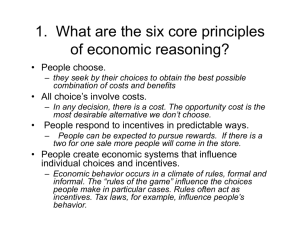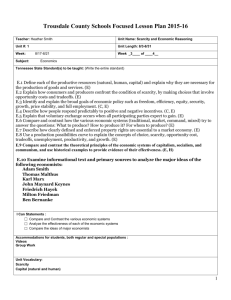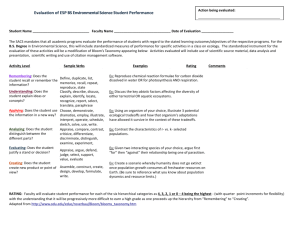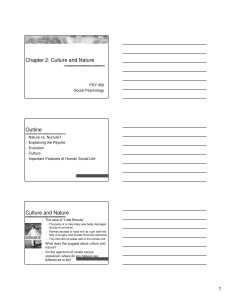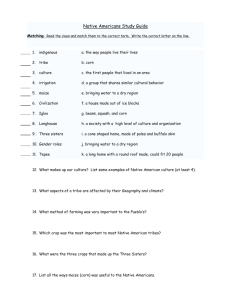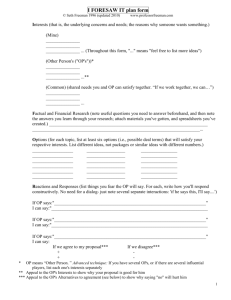Economics on Main Street: Concepts for American Voters
advertisement
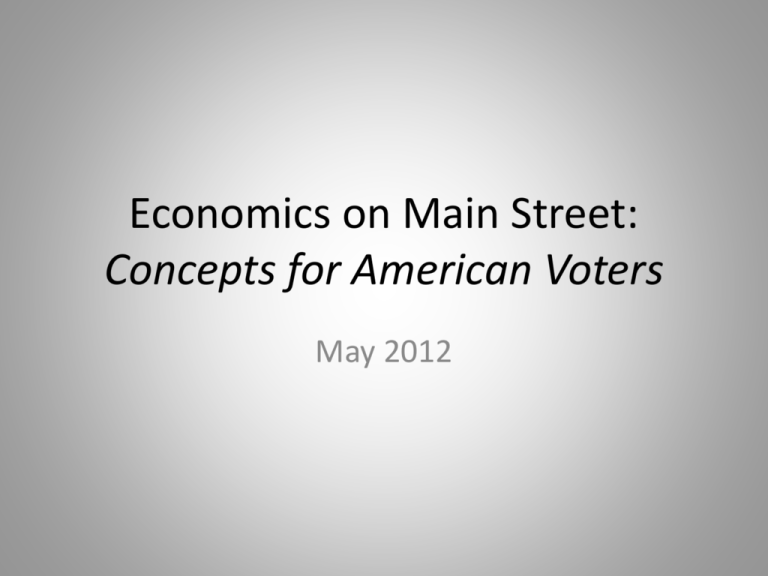
Economics on Main Street: Concepts for American Voters May 2012 Introductory Notes • About the Prof (introduction, questions?) • About the Students (please fill out & turn in) • Sessions and Topics (see next slide) Sessions & Topics • Fundamental Tradeoffs and Economic Growth • Markets Are Perfect, Except When They’re Not • Income Inequality & Jobless Recoveries • Public Goods & Sustainable Social Contracts Fundamental Tradeoffs and Economic Growth (1) fundamental tradeoffs Dylan, a sophomore at ISU, is considering what to buy this week. He wants the latest IPod Touch and Beats headphones. He wants a portable computer so he can take some weekend trips and keep up with class work. He wants to take his girlfriend out to dinner at a really nice restaurant back home in Lockport. One of the guys he shares an apartment with has quit school and is leaving. Dylan wants a room of his own. His part-time job is interfering with his school work and he wants to quit work. He saw a new mountain bike at that cycle shop near campus and he wants it. (a) Will all of Dylan's wants be satisfied? (b) What will Dylan have to do? What Dylan Wants • scarcity and tradeoffs unlimited wants, limited resources, choice. opportunity cost in every decision. • applications society (limited land, labor & capital) individuals (limited income, abilities & time) organizations (human, financial & technical) A Primitive Civilization • we are a small primitive tribe ( our goal is simple: survival ) • what are our specific wants? • what are our limited resources? A Primitive Civilization a (0, 15) 15 10 5 f (5, 0) 0 1 2 3 4 5 Shelter (covered rooms) A Primitive Civilization a (0, 15) 15 b (1, 14) Production Possibilities (given known resources) c (2, 12) 10 d (3, 9) e (4, 5) 5 f (5, 0) 0 1 2 3 4 5 Shelter (covered rooms) PPF for a Primitive Civilization a 15 b c Unattainable 10 d 5 e Attainable f 0 1 2 3 4 5 Shelter (covered rooms) Production Possibilities • resources, scarcity & opportunity cost ( opportunity cost = sacrifice / gain ) ( all of our choices involve opportunity cost ) • increasing opportunity cost why? unique resources and alternative uses ( consider tribe resources, food & shelter ) ( a-to-b sacrifice of 1, e-to-f sacrifice of 5 ) ( unique resources, start with low cost options ) Changing Slope of PPF slope of PPF steeper as more shelter is produced . . . . this reflects increasing opportunity cost a 15 b c 10 d e 5 f 0 1 2 3 4 5 Shelter Production Possibilities • resources, scarcity & opportunity cost • increasing opportunity cost • variety of applications society & production decisions, individuals & consumption choices, households & competing uses of time Scarce Resources, Basic Tradeoffs a b Decisions Faced by Every Society? c d e f One Thing Scarce Resources, Basic Tradeoffs a How Much Devoted to Shelter (Housing)? b c d e f One Thing Scarce Resources, Basic Tradeoffs a How Much Devoted to Health Care? b c d e f One Thing Scarce Resources, Basic Tradeoffs a How Much Devoted to ANY GOOD? (subject to increasing opportunity cost) b c d e f One Thing Scarce Resources, Basic Tradeoffs a b Our Choices As Consumers? c d e f One Thing Scarce Resources, Basic Tradeoffs a b c Home Improvement? Dining Out? Travel? d e f One Thing Scarce Resources, Basic Tradeoffs a b c Competing Uses of Time? d e f One Thing Scarce Resources, Basic Tradeoffs dual careers $71,000 two flexible jobs $56,000 $40,000 $18,000 one full time one part time Household Time Scarce Resources, Basic Tradeoffs a b c Retirement Decisions d e f Time Economic Decisions • balancing costs & benefits at the margin required tradeoffs (MC), willing tradeoffs (MB) • society & production decisions food vs shelter? guns vs butter? energy vs ??? who decides (a few alternative approaches)? • a disturbing trend in our public discourse diverse views do not preclude consensus, however . . . it helps to agree on the required tradeoffs (PPF), . . . when interest groups are the information sources. a Consider tradeoffs associated with coal, oil, natural gas & nuclear. b c d e f Energy Production If everyone agrees on PPF then will focus on relative benefits of the two goods. Public choice to select which of available points is preferred. a b c d e f Energy Production a Environmental groups claim severe cost and limited product. Industry groups claim low cost and abundant product. Consensus solution less clear. e Energy Production Fundamental Tradeoffs and Economic Growth (2) sources of economic growth Questions for Our Tribe Our standard of living appears to be constrained by our production possibilities. • can we expand our production possibilities? • what choices make this possible? Food PPF defines limits of current consumption b a Shelter Economic Growth Food m economic growth leads to new possibilities k b old limits g a Shelter Indicators of U.S. Economic Growth Past Present Life Expectancy 40 years (1850) 77 years (2000) Infant Mortality 15% (1850) 0.6% (2000) Time at work to pay for a dozen grocery items 9.5 hours (1919) 1.5 hours (2000) Time at work to pay for a refrigerator 1.5 years (1919) 2 weeks (2000) economic growth around the world (real gdp per capita, average annual growth) 1870 1950 1979 2008 1950-1979 1979-2008 US $3,392 $13,266 $26,070 $43,250 2.3% 1.8% Canada $2,352 $10,116 $22,436 $35,058 2.8% 1.5% Germany & Japan $1,787 $4,025 $18,840 $30,260 5.3% 1.6% Soviet Union $1,308 $3,942 $8,980 $10,967 2.8% 0.7% Mexico & Brazil $963 $2,801 $7,533 $9,996 3.4% 1.0% China & India $738 $741 $1,342 $6,279 2.1% 5.6% Africa $694 $1,233 $2,069 $2,470 1.8% 0.6% Questions for Our Tribe Our standard of living appears to be constrained by our production possibilities. • can we expand our production possibilities? • what choices make this possible? Spring (salmon) Fall (wildlife) Forest Winter (shellfish & berries) River Stone Circles Mountain Summer (fish & roots) Ocean Shallow Cove Sources of Economic Growth • find additional resources – exploration & discovery – tribe example? opportunity cost? • create additional resources – capital investment – tribe example? opportunity cost? (how about population growth?) Sources of Economic Growth • enhance productivity of current resources human capital development – tribe example? opportunity cost? innovation, productive ideas – tribe example? opportunity cost? conservation of natural resources (how about specialization and exchange?) Sources of Economic Growth • investment choices – capital investment , human capital investment, exploration & discovery, innovation, conservation – all have current cost, future benefit Sources of Economic Growth Capital Goods m growth determined by current choices k b g a Consumption Goods Sources of Economic Growth Capital Goods m k current consumption does not promote growth b old limits g a Consumption Goods Sources of Economic Growth Capital Goods m current investment does promote growth k b old limits g a Consumption Goods Sources of Economic Growth • investment choices – capital investment , human capital investment, exploration & discovery, innovation, conservation – all have current cost, future benefit – implications of diminishing returns (growth limited when relying on one source alone) – private (individuals, firms) or public Sources of Economic Growth Private Public Capital Investment Manufacturing Plant & Equipment Transportation Infrastructure Human Capital Choosing to attend and complete college Public support for education and training Discovery Marine geology Marine biology Innovation Intel microchip advances Public support for scientific research Conservation Thermostat setting Building smart grid
